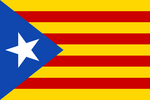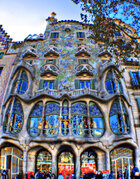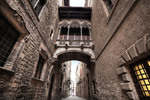-
Social Rituals
Hi everybody !
What better than the day of Sant Jordi to speak about Catalan traditions or culture?
St Jordi's day is Saint George's Day in Barcelona and Catalunya and it is the most romantic day of the year. It is also called "El Día de los Amantes," which means Lovers Day and sometimes called "El día de la Rosa," which means the Rose Day. St. Jordi day is not a public holiday in Barcelona, so shops are open as usual and the main streets as the Rambla Catalunya are crowded.
St. Jordi is Catalunya's version of Valentine's Day and is a one day festival of romance, roses and books all inspired by the legend of Saint George on 23rd April every year. St. Jordi is the patron saint of Catalunya and is celebrated on 23rd April to commemorate his death on that date in the year 303 AD. The legend of Saint George, which you probably have heard, is that he slew a dragon to save a princess. He then plucked a red rose for the princess from a rose bush, which had sprouted on the exact spot where the dragon's red blood had spilled.
On Sant Jordi's day the men in Barcelona and Catalunya give their sweetheart a red rose, and in recent years a new Sant Jordi tradition is that the ladies give the men a book to commemorate both the death of Shakespeare and Cervantes.
This celebration is only one of many feasts that the Catalans celebrate.
For example, the beginning of March is marked by the carnival which begins in Spain with "Dirty Thursday". In Barcelona this day is called “Jueves Ladero” – “Greasy Thursday”, or “Dijous Gras” in Catalan. This day is dedicated to the "Greasy" and "Vice" and celebrated with many festivals in which vast amounts are eaten.
The weekend belongs to the Carnival Guilds. The Rambla is highlighted due to the big carnival Parade with loads of colorful decorated carriages and carnival Groups.
 On Ash Wednesday the carnival comes to an end with the funeral of the sardine. The King of Carnival dies and is buried in his grave in a funeral cortège, accompanied by his widow and companions - the colorful costumes are appropriately exchanged to black mourning clothes. Traditionally, on this day fish is eaten.
On Ash Wednesday the carnival comes to an end with the funeral of the sardine. The King of Carnival dies and is buried in his grave in a funeral cortège, accompanied by his widow and companions - the colorful costumes are appropriately exchanged to black mourning clothes. Traditionally, on this day fish is eaten.Easter is also here a special celebration. Traditionally, Easter Week or "Semana Santa" begins on Palm Sunday and ends on Easter Monday.
Easter is one of the best times to spend a few days in Barcelona. Spring is already here, tourists are less numerous than in summer, and parades of religious processions are impressive.
Palm Sunday is the last Sunday of Lent and Sunday just before Easter. There is a religious procession around Barcelona Cathedral, which dates from the 13th century. It is located in the Barrio Gotico, the artists' quarter. The parade is intended to bless the branches of Palm which are then offered by the gofathers to their godchildren.
During the Holy Friday we can attend the parade given in
 honor of the "Virgen de la Macarena", the Patron Saint of Barcelona. The parade takes place in front of the Church of Sant Agusti in the Raval to reach the Cathedral of Barcelona in the Barrio Gòtic. This procession is characterized by “Costaleros”: members of religious congregations carrying a large statue of Mary through the city.
honor of the "Virgen de la Macarena", the Patron Saint of Barcelona. The parade takes place in front of the Church of Sant Agusti in the Raval to reach the Cathedral of Barcelona in the Barrio Gòtic. This procession is characterized by “Costaleros”: members of religious congregations carrying a large statue of Mary through the city. The "Semana Santa" is also the best time to test the traditional Catalan dishes. The Holy Friday, Christians eat fish instead of meat, often of cod. You can also try different pastries and biscuits as "Buñuelos" and "Mona de Pascua". A Buñuelo is a kind of donut stuffed with chocolate and La Mona de Pascua is a traditional recipe which is also given to godchildren on Palm Sunday.
The "Semana Santa" is also the best time to test the traditional Catalan dishes. The Holy Friday, Christians eat fish instead of meat, often of cod. You can also try different pastries and biscuits as "Buñuelos" and "Mona de Pascua". A Buñuelo is a kind of donut stuffed with chocolate and La Mona de Pascua is a traditional recipe which is also given to godchildren on Palm Sunday.In general, life in Barcelona is much more relaxed than the one we have in France. Indeed, businesses are often not open until 10 or 11 am and close between 14 and 16 pm to re-open three or four hours. People do not run in the subway and are relatively quiet.
However, the Catalans are able to move mountains and be very
 well heard when it comes to their independence. And this can even be seen regarding the Catalan Flag hung on almost every balcony Barcelona.
well heard when it comes to their independence. And this can even be seen regarding the Catalan Flag hung on almost every balcony Barcelona.The flag of Catalunya, known popularly as the Catalan senyera, is
 the traditional flag
the traditional flag
four horizontal bands of red on gold, the old colors of the coat of arms of the House of Barcelona and then the coat of arms of Catalonia and the Crown of Aragon. It is official since 1979. But Catalan recently modified it and created a new one, the estelada, which is the flag that symbolizes the demand for independence of Catalunya and the Catalan country compared to Spain and France. It consists in a senyera to which a triangle luff wearing a star in the center was added.
of Aragon. It is official since 1979. But Catalan recently modified it and created a new one, the estelada, which is the flag that symbolizes the demand for independence of Catalunya and the Catalan country compared to Spain and France. It consists in a senyera to which a triangle luff wearing a star in the center was added.Barcelona has also a real distinctive and beautiful architecture. Bold, brash, colourful, distinctive,
 harmonious,varied and unique are just a few adjectives that come to mind when
harmonious,varied and unique are just a few adjectives that come to mind when describing it. Barcelona has successfully blended the old and the new in a way that makes this city simply breathtakingly beautiful. There is nothing more enjoyable than strolling around the streets of Barcelona and taking in the atmosphere that radiates out from the architecture. Traditional Catalan Gothic architecture such as the Iglesia de Pi church is reserved and stoic in its design, but just a 5 minute walk away we have the Barcelona Cathedral with is beautiful arches and facade. A short metro ride we have the famous Sagrada familia Basilica which towers brush against the sky.
describing it. Barcelona has successfully blended the old and the new in a way that makes this city simply breathtakingly beautiful. There is nothing more enjoyable than strolling around the streets of Barcelona and taking in the atmosphere that radiates out from the architecture. Traditional Catalan Gothic architecture such as the Iglesia de Pi church is reserved and stoic in its design, but just a 5 minute walk away we have the Barcelona Cathedral with is beautiful arches and facade. A short metro ride we have the famous Sagrada familia Basilica which towers brush against the sky.
Central Barcelona can be separated into three main areas. On one side, the old town or Barri Gòtic which was the original Barcelona characterised by winding old streets and tall dark buildings ancient buildings. And on the other side, the Raval area which was an extension to the original old town and finally Eixample which is the large organized "grid" structure area that was appended to the old town. Each area has its own unique and distinctive character.
On one side, the old town or Barri Gòtic which was the original Barcelona characterised by winding old streets and tall dark buildings ancient buildings. And on the other side, the Raval area which was an extension to the original old town and finally Eixample which is the large organized "grid" structure area that was appended to the old town. Each area has its own unique and distinctive character.To conclude, Barcelona is a marvel in terms of architecture. It is also a really pleasant city to live organized around various events, religious or not.
-
Commentaires

